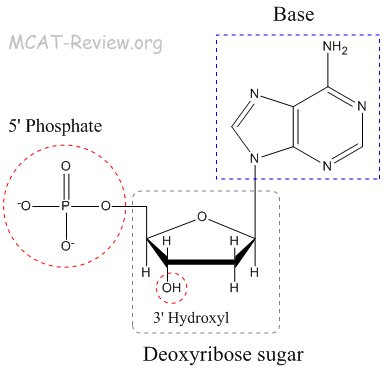 |
| Source: http://sciencenotes.files.wordpress.com/2008/04/dna-helix-diagram.jpg and http://smapp.rand.org/ise/ourfuture/Rosetta/images/DNA.gif |
a. 5-Carbon Sugar
b. Nitrogenous Base
c. Phosphate Group
 |
| Source: http://www.abpischools.org.uk/res/coResourceImport/modules/genome/en-images/nucleotide.gif |
 |
| Source: http://mcat-review.org/molecular-biology-dna.php#composition |
For DNA, there are 4 different nucleotides categorized as either "Purines" or "Pyrimidines". They are:
a. Adenine (A)
b. Cytosine (C)
c. Guanine (G)
d. Thymine (T)
 |
| Source: http://cs.boisestate.edu/~amit/teaching/342/lab/structure_files/DNAnucleotides.gif |
- Each "Rung" of the DNA "staircase" is formed by the linking of 2 nucleotides through Hydrogen Bonds.
- These Hydrogen bonds form only between specific nucleotides. This is known as Base Pairing. The rules are as follows:
b. Cytosine (C) will ONLY bind to Guanine (G) (by 3 hydrogen bonds)
 |
| Source: Encyclopedia Britannica, Inc. (1998) |
5. Function of DNA
DNA has function in Transmission of Genetic Information, the main is function of replication in the cell, that are:
a. Duplicating DNA.
b. Chromosomes duplication.
And it also has some side effects, like:
a. Duplicating DNA.
b. Chromosomes duplication.
And it also has some side effects, like:
a. Proteins must have the correct shape.
b. The shape is determined by the primary structure (amino acid sequence).
c. The amino acid sequence is determined by the gene (the sequence in the bases in the DNA).
Below is the flow of genetic information in the cell:
 |
| Source: Thomson-Wadsworth (2003) |
Challenger for the replication process:
1. Separate the two strands - protect the unwound strands from the nuclease.
2. DNA must be synthesized from 5' to 3'.
3. Protect against errors during synthesis.
No comments:
Post a Comment